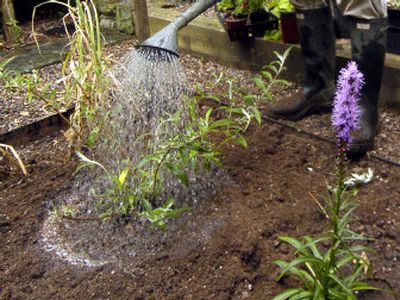From pots to garden traumatic

The simple plastic pot came along after World War II and revolutionized the gardening industry. Plants that once were available only in early spring, bare-rooted and dormant, could be grown, shipped and sold at virtually any time of year.
This has been a boon to grower and home gardener alike: Almost 80 million annuals alone are sold each year in some form of plastic container. In garden centers throughout the land, perennials, shrubs and trees in pots as large as 5 gallons are consumed by homeowners looking to fill out their yards or plant virgin landscapes.
But a plant’s life-changing transfer from pot to garden bed is not an easy passage, and for its new owner there may not be a lot of guidance available at that critical, lonely moment. In that vein, we offer these thoughts:
Roots develop quickly in young, nursery-grown plants, because they are fed and watered a lot. When they reach the wall of the pot they start circling, in time taking on the shape of the container. Heavily congested roots are called pot-bound, and they yearn to be set free. But when you do release them, they have to be coaxed out of their orbit or they will go on spinning in circles. The plants have to be set in loosened soil as well, so the roots can venture forth, developing a network that will grow big and healthy.
So, if you dig a hole the size of the container but fail to spread out the roots, you might as well bury the plant still in its container. Such a plant is marked for slow decline; it will never develop a root system large enough to supply moisture and nutrients to an ever-growing top. And it may girdle, a condition in which the encircling roots actually strangle the trunk.
Most people understand this, but still fear they will harm the plant by tearing at the roots.
“Where people err is on the side of being too hesitant to rip at a root ball,” said Jon Traunfeld, a horticulturist at the University of Maryland Home and Garden Information Center. “That will just stimulate the plant if it’s otherwise healthy.”
But one standard procedure for doing this does not apply to every plant, because each root system is different: A lavender’s roots are fine but fibrous, those of a liriope are thick and fleshy. Also, root density is directly related to how long a plant has been in a pot.
The best tools for this job, I have found, are a pair of bare hands and a sharp knife, in that order. By kneading the root ball with the palms of your hands, you discover quickly whether the mat of roots is thick and solid throughout the pot. This determines how deeply you score them with the knife.
A root system that is not excessively pot-bound can be scored north, south, west and east, and the bottom third of the ball is then butterflied and planted. Roots that are thicker benefit from a light scoring every 2 or 3 inches around the root ball. The knife goes deeper in thick root balls: One of the key objectives is to break up the mat of roots that inevitably grows at the bottom of the pot.
Fred Miller, extension director for Catawba County, N.C., suggests shoppers at a nursery slip off the pot to see the state of the roots. Roots growing through the drainage holes on the bottom may make that difficult, but they hint that the plant within is seriously pot-bound.
Perennials and shrubs with congested roots can be fixed, but container-grown trees with seriously pot-bound roots may struggle their whole lives. “I advise (consumers) not to purchase a pot-bound tree,” said Miller. “Oftentimes these trees will give them a lot of problems: It’s more difficult to grow out of those girdling characteristics.”
With a heavily pot-bound shrub or perennial I want to keep, I have patiently hosed away all the growing medium and then set about untangling the mess as if it were a badly knotted ball of yarn.
Most annuals are purchased between late April and early July, and have been started from seed in greenhouses in January. Their root systems, being young, are typically far more frail than those of hardy plants that have had a season or two to develop. Go easy on them. Often, the roots have formed a mat at the bottom of their pot, which will unravel to form a long strand. This either can be planted intact in soil that is deep enough, or trimmed off.
In planting, don’t set the plant too deeply, a practice that can induce root rot. “The plant is set at the same level as in the container or slightly higher, but never lower,” said Charles Brun, an associate professor of horticulture at Washington State University.
He reiterates the standard advice that a hole should be no deeper than the pot and three times its diameter. In clay soil, the sides of the hole should be broken up to prevent the clay from forming a barrier to roots.
Often, breaking up the root ball results in a root system that is shallower than when it was in the pot. You may have to backfill some of the hole to establish the correct height. On more fragile annuals, herbs and small perennials, I hold the plant at the proper height with one hand and backfill the hole with the other.